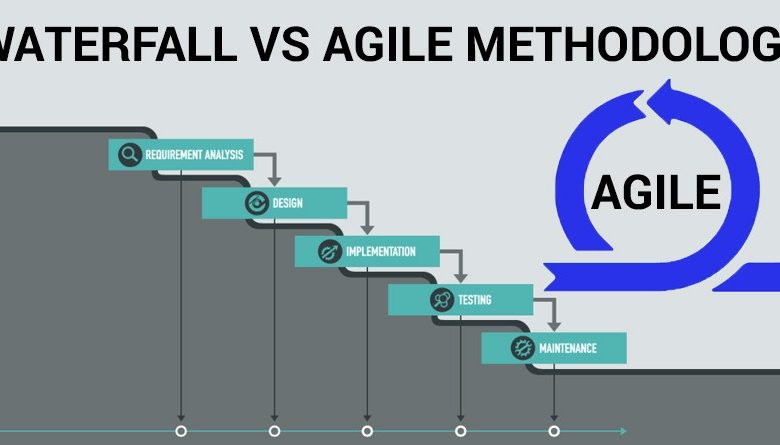A Guide on Waterfall Testing Methodology

What is the Waterfall Testing Methodology
The Waterfall testing methodology is also referred to as the linear development process. This project management method flows like a waterfall via all stages of project development. The analysis, design, development, and testing. In Waterfall, the project development teams ensure a progression track where teams finish each step before approaching the next one.
Waterfall’s popularity is hovering with extensive agile method adoption over the years. IT Companies prefer it due to its rational nature and straightforward implementation. Waterfall follows the “measure twice, cut once” principle. The success of this method depends on the quality of the work put in. From proper documentation to the necessary user interface with intact features and variations.
Developers collect the stakeholder’s and customers’ requirements in the project’s initial phase to plan the workflow. Since teams finish most of the research and resource gathering upfront, it becomes easier to predict a release date.
But, the noteworthy setback with Waterfall is – If the parameters change along the process, it’s tedious to make corrections. Thus Waterfall vs Agile testing is a heated choice to settle around.
Advantages of the Waterfall testing methodology
As we discussed earlier, despite the vast adoption of agile, Waterfall remains a choice for several IT or software companies. It ensures a demonstrated track record with a well-defined, straightforward project management method. Since the requirements are around from the initial state, it reduces time and keeps the team’s focus intact. Each stakeholder is aware of their defined contributions with timelines for an effective project plan.
The advantages of Waterfall doesn’t end here-
- It carries a detailed and well-documented testing process.
- After defining the requirements, product managers can estimate the project’s cost and timelines.
- The structured approach makes it easier to measure progress according to defined milestones.
- Waterfall testing methodology fits the complex projects.
- Teams develop the distinct features of the projects and deliver them.
- It cuts out on unnecessary documentation and time exhaustion during the process.
- Developers and designers can enhance speed since the requirements are already over.
- Different stakeholders involved are not dependent on each during. Instead, they can do their parts independently.
- Customers can’t add new responsibilities during the project’s ongoing, which delays the production.
- Even in changing teams or shifts, it’s easy for the whole team to execute the final product with Waterfall.
- In the Waterfall testing methodology, every process has a strict reviewing session. It avoids recurring mistakes or loopholes getting carried forward.
Drawbacks of the Waterfall testing
Like any other development testing process, strengths in one area mean significant weaknesses too. The rigid waterfall methodology claims upfront commitment and planning for the project. The strictness makes it less adaptable and flexible during the final product in the changing market conditions. Now that the consumer requirements and market patterns are changing, the process becomes resource exhaustive to make modifications later on.
- It requires excessive documentation and a rigid structure.
- The chronological order can also delay the project delivery, unlike an iterative one.
- The design and implementation don’t directly involve the client’s involvement.
- It’s not unnecessary for clients to always be clear on their requirements. It can keep shifting with time, thus accomodating these modifications later becomes difficult.
- It can become highly time-consuming when there is a delay in one phase, delaying the whole cycle.
- Large-scale projects are not suitable with Waterfall.
Different Phases of waterfall project management
The waterfall testing methodology is a sequential process that combats one specification at a time. Different stakeholders are not expected to be cross-functional while juggling the tasks since one stage doesn’t end until the earlier one finishes. The chronological phases of the system are as follows-
Requirements-Design-Implementation-Testing-Deployment-Delivery
Requirements
The primary facet of the waterfall methodology’s success relies on that teams can assemble and apprehend the speculation of project requirements at the beginning. The customers’ and the stakeholder’s needs are combined into a document that guides the workflow. The project managers ensure all essentials of the project sponsor’s requirements are around to cut further customer involvement, and the team plays independently during the process. These requirements include risks, costs, metrics, timelines, etc.
Design
After the established requirements, the design team is handed over the product requirements, including layouts, scenarios, data structures, etc. These specifications determine the project’s scope and the expected traffic flow at each stage. However, during the design phase, no coding takes place. Instead, the team transforms these specs into physical design using the software and hardware requirements.
Implementation
Once the design process is over, the technical implementation is functional. Developers carry out the information and research from the initial phases and build a valuable product. Yet, interestingly coding is the shortest step of the waterfall process since the meticulous study and designing is over. Rest, the developers write code to meet specifications outlined in the initial stages.
Verification or testing
Once the developers complete the code, they test it before releasing it to customers. It ensures the final product does not have any errors or loopholes and it’s eligible to provide an excellent user experience. The testers test the design documents, user cases, and personas the project manager offers to create test cases.
The testers and quality assurances can find and report such errors. In case of severe issues, the project may require returning to the initial stages for reevaluation.
Delivery/Deployment
Once the execution with the testing team is successful, the product is ready for delivery. The team will present the deliverables with deployments in the market.
Maintenance
Deployment doesn’t mean your responsibilities have finished. Keeping the application functional and current requires ongoing support by designers and developers. If maintenance teams find a defect, the application requires modifications. A team works to ensure the consumer requirements, releases, and update new versions
Bottom line- When should organizations follow the Waterfall approach
- When the project doesn’t require ambiguous commitments
- When the Clients are unlikely to keep changing the project’s scope.
- When teams are successful in defining the comprehensive project outcome and idea.
- With proper time, cost, and design, project managers are free to adopt Waterfall for their project’s success





